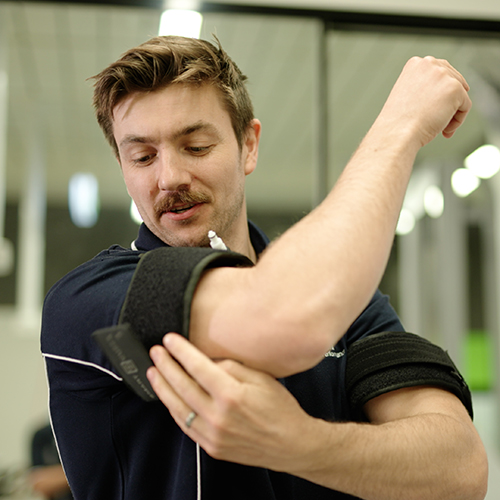01 July 2025
 It’s a debilitating disease that affects more than 500,000 Australians, but new research from the University of South Australia is offering fresh hope to people living with rheumatoid arthritis (RA).
It’s a debilitating disease that affects more than 500,000 Australians, but new research from the University of South Australia is offering fresh hope to people living with rheumatoid arthritis (RA).
Evaluating the effectiveness of a novel form of exercise – blood flow restricted resistance training – among people with RA, researchers found that this alternative workout method not only improved their strength and physical performance, but also reduced their pain.
Blood flow restricted resistance training involves placing a pneumatic cuff – much like a blood pressure cuff – around the top of the working limb. The cuff is then inflated so that it restricts blood flow out of the limb, creating a highly metabolic environment which forces the muscles to work harder, even when using lighter weights or less effort.
The Arthritis Australia funded study is the first to trial blood flow restricted resistance training on both the upper and lower limbs in people with RA, using five exercises – leg press, machine hamstring curl, machine knee extension, cable tricep extension, and cable bicep curl – with gradually increasing weights.
All participants in the study reported that they “liked” the program, and the group showed clear improvements in strength, movement and pain levels.
Lead researcher UniSA’s Dr Hunter Bennett says the training offers a practical and achievable option for people with RA.
“RA can cause a loss of muscle mass and strength, which affects day-to-day activities, independence, and increases the risk of falls and fractures,” he says.
“Resistance training is one of the best ways to rebuild that strength, but for people with RA, using heavy weights can be difficult or harmful due to pain, fatigue or injury risk. This is where blood flow restricted resistance training can help.”
Dr Bennett says this approach is ideal for people who need to do resistance exercises but find it hard to lift weights.
“Many people with health conditions are understandably deterred by exercise, yet it is often one of the best things they can do to improve their condition,” he says.
And while this exercise might look unusual, the research shows that it works.
“This kind of training could be a game-changer for people with rheumatoid arthritis.
“It offers a way to build strength and reduce pain without pushing through discomfort – and that’s incredibly empowering for people who’ve often been limited by their condition.”
While this was a small-scale trial, researchers say the results are promising and lay the foundations for a larger trial comparing blood flow restricted resistance exercise to more traditional exercise approaches.
…………………………………………………………………………………………………………………………
Contact for interview: Dr Hunter Bennett E: Hunter.Bennett@unisa.edu.au
Media contacts: Annabel Mansfield M: +61 479 182 489 E: Annabel.Mansfield@unisa.edu.au
Josh Owen-Thomas E: Josh.Owen-Thomas@unisa.edu.au




